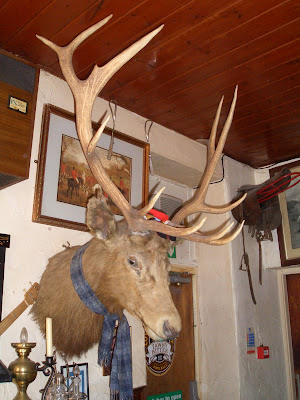

Just past a bridle path on our left signed to Kemacott, we turned right through a hunting gate into the footpath across Martinhoe Common which led to Slattenslade. We marched straight across the middle of a pasture still soaking with dew and, passing through another hunting gate, crossed a lane into a huge field of cattle and sheep. We kept close to the right hand boundary and after negotiating two 5-bar gates found ourselves in the lane above Slattenslade. We turned right down to a cottage and here turned left to climb up towards the car parks above Woody Bay. At a crossroads we bore right downhill and, at a hairpin bend, turned off left into the bridleway which leads to Hunters Inn.
This is a good, broad track along which we marched at a smart, Somerset Light Infantry pace through a woodland of old oaks which stretched away down to the sea far below. It was a beautiful, sunny morning with a veil of haze where the sea faded into the sky.


The bridle path, however, suited us fine, and we bowled along towards Hunters Inn. As usual a smattering of dog walkers warned us that we were getting nearer and, after passing into the woodland above Heddons Mouth, suddenly the pub was there before us. It was too early for more than a handful of customers, and we walked past the entrance and over the river before turning left into the path which led us up the valley, first through Invention Wood and then Heale Wood until we crossed the foot bridge to regain the road. Opposite was Mill Farm, whose chimney was one of those wondrous structures which have stood for so long that their stonework appears to have metamorphosed into some strange vegetable matter. It was guarded by an elderly terrier who was enlivening his twilight days by playing chicken in the road.





There were three proper beers, all racked up behind the bar and served straight from the barrel at the best of temperatures. Ever dedicated to drinking anything new to us, we started for the purposes of research with a pint each of Bays Gold. Bays Brewery has been brewing in Paignton only since last year, and its Gold is a typical, lemony, bitter bitter of that ilk. If you like these citrus-type ales, you will like Bays. We are not that crazy about them, and we moved on to an old favourite, Cotleigh’s Barn Owl, a dark-red kind of junior porter which we find irresistible. The Fox & Goose takes its food seriously, and charges accordingly. You can get a sandwich for less than five pounds, but the fresh fish dishes were only just short of £15 and a fillet steak would set you back £16. The cooking obviously enjoys a reputation as on a Friday lunchtime there was a respectable number of people eating. It was a grand place to sit, however, and enjoy a five star pint.
We turned left out of the pub and walked up the narrow, winding street before taking a lane to our right which led past an obviously Victorian gothic revival church. We continued past the primary school until a track led us to the original parish church of St Petrock, usually identified as a Cornish saint – Padstow is supposed to be a corruption of his name – although he was the son of a Welsh king and gives his name also to churches in Devon and Somerset. The church dates from the eleventh century and since 1879, when the other church was first planned, has disappointed all those who have expected it to fall down. John Ruskin, who donated £10, was among the many who contributed to ensure that it was not demolished and the new church built on its site. The Georgian interior is quite unspoiled with a splendid screen and lovely box pews.

 We continued up the track and crossed the A39, climbing by one of the various paths at the foot of Parracombe Common. We reached a lane, turned left, and soon found the road which led us back to Martinhoe Cross and Woody Bay Station. Just before the main road there was pull-in where one could have parked if necessary.
We continued up the track and crossed the A39, climbing by one of the various paths at the foot of Parracombe Common. We reached a lane, turned left, and soon found the road which led us back to Martinhoe Cross and Woody Bay Station. Just before the main road there was pull-in where one could have parked if necessary.


No comments:
Post a Comment